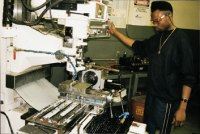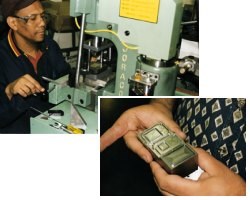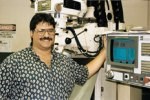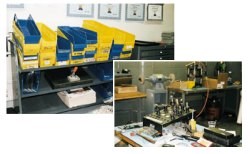Growing Into CNC
Like many manufacturing enterprises, this New York shop started with the most basic machine tools and processes. In just six years, they've gone from virturally zero to almost $40 million in sales. Here's a look at how the company's manufacturing has had to evolve to keep up with triple-digit growth in the sales of its products.
Share



.png;maxWidth=45)
DMG MORI - Cincinnati
Featured Content
View More
ECi Software Solutions, Inc.
Featured Content
View More


Takumi USA
Featured Content
View MoreNow this is growth: At last count, Schick Technologies Inc. (Long Island City, New York), had 340 people on the payroll at its headquarters and another 150 direct sales people in the field. The company started with just three employees in 1992.
Schick is a leader in digital radiography. Used extensively in dentistry, it's an alternative to traditional film X-ray. It also can be applied to inspection of metal components. The technology currently is being used to X-ray jet engine and aerospace components for defects.
An analogy of digital radiography is to compare the imaging technology of a digital camera to a film camera. Digital film takes light and converts it to an electronic signal. Film, of course, uses a chemical process to capture an image. Unlike a camera that uses light to create an image, the equipment that Schick works with generates X-rays to fix an image on an electronic sensor. A digital sensor records the X-ray image and transfers the image to a computer CPU.
Schick's in-house manufacturing capacity has expanded in capability along with the company's success in the market. The company uses bed-type mills to great advantage in their in-house machine shop. The capability to machine in either manual or CNC mode has helped the shop grow its skill sets and capabilities in concert with the company's growth while maintaining the requisite flexibility of a captive job shop.
A Critical Component
At the heart of the Schick digital radiography system is the digital sensor. It's the component that replaces film in the dental X-ray unit and is a key piece of technology for other products the company manufactures.
Steve Mita is Schick's machine shop manager and manufacturing engineer, and he's also employee number seven. "We're always modifying the parts that make up these sensor units," says Mr. Mita. Imbedded in the sensor is an electronic chip. It, in turn, is housed in a stamped aluminum cover called a can. Each can has a top and bottom that snap together. Machining tolerances for the dies to stamp these parts are +0.0005-inch perpendicularity and +0.001-inch parallelism.
The shop machines the dies and molds for the can and its molded plastic cover. This sensor component is made in three different sizes and it is what goes into the dental patient's mouth instead of the X-ray film.
"Because we're firing X-rays into these sensors and because they are a type 1 medical device (meaning they are in direct contact with a patient), these sensors must be made exactly and with high repeatability," says Mr. Mita.
The Shop's Role
When the company began, it was decided that, as much as possible, volume production of parts would be done on the outside. The company's products are assembled and tested in-house but part production manufacturing uses vendors.
Schick's shop plays a large role in getting the company's designs from R&D into the hands of the vendors. The shop's three-fold role, including product development, process prove-out and occasional overflow production, was in place from the very beginning and continues to evolve.
Schick's first role is to work with the research department to manufacture and prototype one-off parts used in that group's continuous product development efforts. "Sometimes they might bring us a completely new design and we would start from scratch," says Mr. Mita, "or we may need only to make a few dimensional changes on an existing part. Regardless, thoughput time is critical."
Second, the company develops the manufacturing process for machining the dies and tools needed to manufacture the various parts that make up the company's line of digital radiography equipment. By doing first article runs, it establishes manufacturing processes that are then given to one of 15 outside vendors for production quantities. An example of process prove-out is Accudexa, a new product, developed for testing bone mass density in potential osteoporosis patients. "We produced the parts for the first 250 units shipped," says Mr. Mita. "We proved out the processes and then turned production over to vendor shops. There are now more than 2,000 units in the field."
As most shops that deal with outside suppliers will attest, sometimes deliveries are not as promised. "Things happen," says Mr. Mita. So in addition to functioning as a prototype shop, Schick's shop also can and does run production for critical delivery situations. "We're fully capable because we proved the process in the first place. We keep duplicate programs, fixturing and tooling at the ready. All our process documentation is in place as we recently received ISO 9000 certification. It's an emergency service our shop can perform."
Much of the credit for the shop's performance—routine and emergency—goes to the move from strictly manual to combination manual and CNC machines. This has made the shop not only more effective in its three-prong role but much more efficient.
"Because of the programming flexibility CNC has brought to the shop, we can respond in hours to prototype jobs that once took days to get done. Plus, once we get the first part we very quickly make as many as they need—even families of different sizes."
Establishing The Need
When Schick's shop started, money was very tight. The machinist (Mr. Mita) had to find ways to do without. One of the first prototype plastic molds he made took more than 10 hours of machining time on a table top manual mill, which was the shop's machine tool inventory.
"We still make a version of that mold but now we cut it in three hours total including programming updates, engineering and setup," says Mr. Mita. "We can also use program edits to make engineering changes that used to require starting from scratch on the manual—that's another 10 hours."
It was the need for rapid turnaround that moved Mr. Mita to investigate higher tech machine tools for the shop. That search led them to Fryer Machine Systems Inc. (Patterson, New York), which was also getting started in the manufacture of machine tools around the same time. Schick now has three of their bed-type CNC mills and one of their CNC lathes. "We've grown together," says Mr. Mita.
"One case in point helped provide the justification that put the shop into CNC machining," recalls Mr. Mita. "We sent out bids to some local machine shops to produce a relatively simple mold set. The quote came back at $120,000 with a 6-week delivery. That was unacceptable so we began looking at how to beef up our in-house capability."
Spending only a fraction of the quoted money, Schick bought its first Fryer mill and two small injection molding machines. "We cut the mold, squirted the parts and still had $50,000 left from the quote," says Mr. Mita. Needless to say, the machines have more than paid for themselves on that and subsequent projects.
Advantages
As machining demands on Schick's shop increased, the bed mills, with CNC operational capability, have become invaluable by allowing the shop to do a better job of planning. A library of process information was built from programs for various parts that were created either with the teach feature of the machine or off-line.
An advantage of the Fryer mill and other machines like them is that they allow a shop to easily capture and document manufacturing and process data that historically resided in the machinist's head. Additionally, because they are both manual and CNC capable, training issues are more easily handled.
"The transition from me making a part on our manual mill to writing a program and then showing a non-machinist how to execute the program is a much smaller step with this technology," says Mr. Mita. "Our setup lets us take people with lower initial skill sets and teach them machining much faster with these machines."
Schick's shop is responsible for making prototypes for the company's R&D efforts. Internal scheduling has been helped dramatically with the use of CNC machines. Many of the tools and parts that must be made can be estimated much more accurately as far as how much time is required to produce them.
"We've seen a reduction in leadtime from 2 weeks to, in some cases, 8 hours," says Mr. Mita. "We've gained a lot of flexibility in both scheduling and response. Most important we're making better parts faster."
Just Edit It
Generally, part programming is done at the machine. Mr. Mita gets into the picture only when the time needed to program a new or revised part is more than three hours. Then he'll write it off-line and either DNC it to the machine or cut a disk for the operator.
In the parts mix that Schick manufacturers, many changes to the workpieces tend to be evolutionary. Often they are small adjustments to a single dimension that can be easily made with a simple program edit.
The shopfloor programming features of CNC enable the operator to make these small tweaks in stride. "Rapid response to our internal customers is job one in this shop," says Mr. Mita. "We can significantly reduce the time required to respond with the CNC machines."
Another advantage the shop has seen with CNC is the ability to partially machine parts that are frequently changed and then hold them semi-finished until needed by the research folks. "With offset capabilities of the CNC, repositioning fixtures and searching forward in the program is not a big deal," says Mr. Mita. "Our can is one of those parts. Its history tells us that only certain dimensions tend to change (it's often an adjustment to the radius on the can) so we can cut most of the tool and leave stock on the radius. When needed, we put the part on the machine, find the appropriate line of code and then finish the part."
What's Appropriate
Many factors influence the selection of the appropriate technology for a given shop and its applications. For shops like Schick, an important goal is to retain flexibility and ease of use without sacrificing machining speed and accuracy.
Machines like the Fryer mill are built for this purpose. Some call them toolroom machines, and this term describes their traditional metalworking niche. However many shops are finding good use for the manual or CNC run mode capability of these bed-mill machines outside the toolroom.
Prices are also attractive for these machines. "Our first CNC machine cost under $30,000," says Mr. Mita. For Schick and shops like them operating on lean budgets, they can afford to replace or augment their less sophisticated machines with those that can deliver better throughput and better overall shop control. "It's throughput that we're looking for," says Mr. Mita, "but without the data collection provided by the CNC disipline, getting ISO 9000 would have been difficult."
In an industry where finding trained workers is increasingly difficult, many shops are turning to technology that delivers what is essentially on-the-job training. As the operator learns the machinist trade, good parts are going out the door.
"We have to be patient training our people because their skill sets are pretty basic," says Mr. Mita. "In the long run, the ones who make it realize there is good opportunity in this trade and we reinforce that every day."
Read Next
Registration Now Open for the Precision Machining Technology Show (PMTS) 2025
The precision machining industry’s premier event returns to Cleveland, OH, April 1-3.
Read MoreBuilding Out a Foundation for Student Machinists
Autodesk and Haas have teamed up to produce an introductory course for students that covers the basics of CAD, CAM and CNC while providing them with a portfolio part.
Read More5 Rules of Thumb for Buying CNC Machine Tools
Use these tips to carefully plan your machine tool purchases and to avoid regretting your decision later.
Read More






































.jpg;maxWidth=300;quality=90)









.jpg;maxWidth=300;quality=90)





